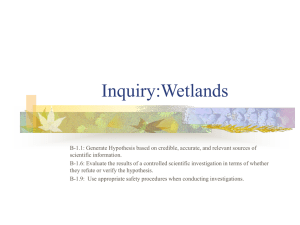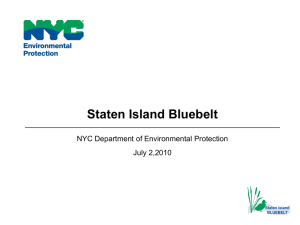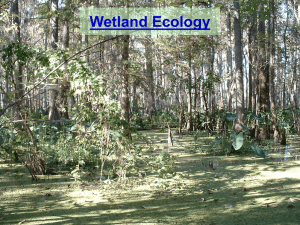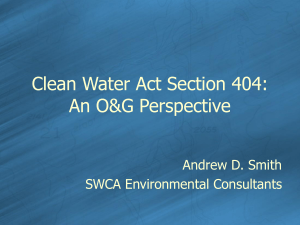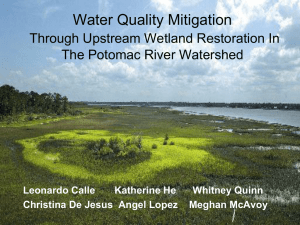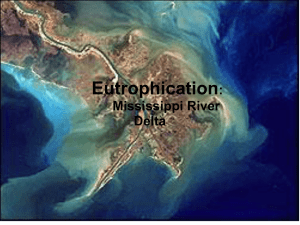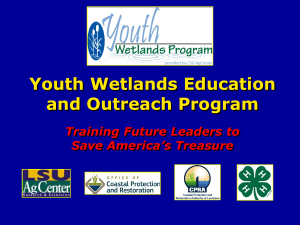inquiry-lesson-plan-wetland
advertisement
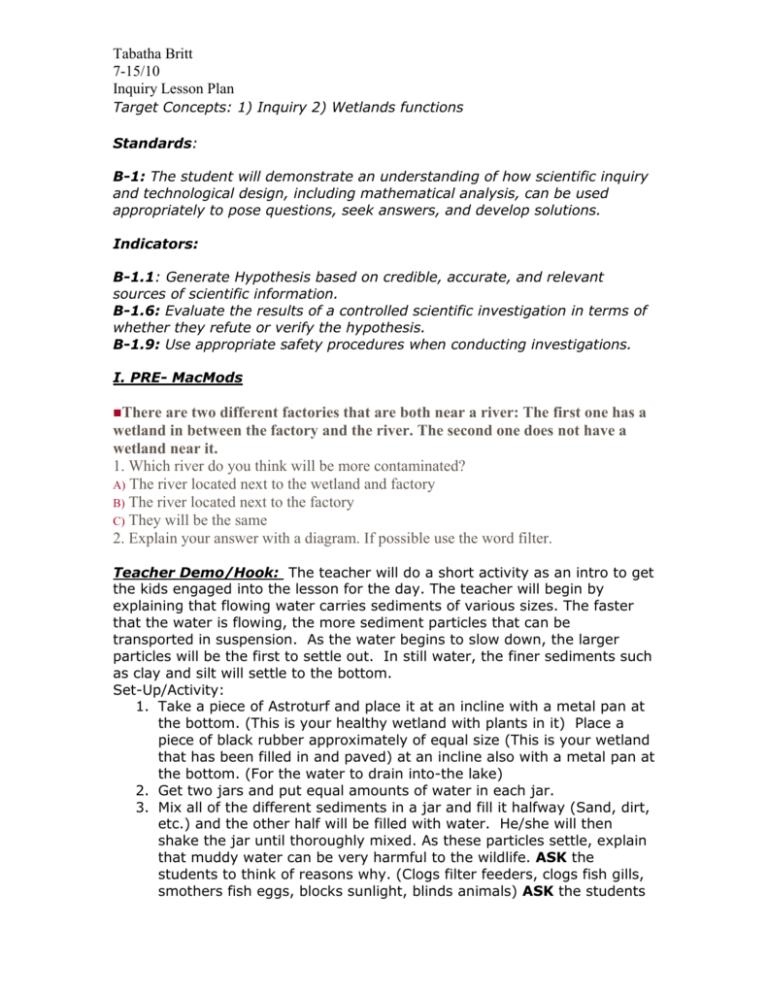
Tabatha Britt 7-15/10 Inquiry Lesson Plan Target Concepts: 1) Inquiry 2) Wetlands functions Standards: B-1: The student will demonstrate an understanding of how scientific inquiry and technological design, including mathematical analysis, can be used appropriately to pose questions, seek answers, and develop solutions. Indicators: B-1.1: Generate Hypothesis based on credible, accurate, and relevant sources of scientific information. B-1.6: Evaluate the results of a controlled scientific investigation in terms of whether they refute or verify the hypothesis. B-1.9: Use appropriate safety procedures when conducting investigations. I. PRE- MacMods There are two different factories that are both near a river: The first one has a wetland in between the factory and the river. The second one does not have a wetland near it. 1. Which river do you think will be more contaminated? A) The river located next to the wetland and factory B) The river located next to the factory C) They will be the same 2. Explain your answer with a diagram. If possible use the word filter. Teacher Demo/Hook: The teacher will do a short activity as an intro to get the kids engaged into the lesson for the day. The teacher will begin by explaining that flowing water carries sediments of various sizes. The faster that the water is flowing, the more sediment particles that can be transported in suspension. As the water begins to slow down, the larger particles will be the first to settle out. In still water, the finer sediments such as clay and silt will settle to the bottom. Set-Up/Activity: 1. Take a piece of Astroturf and place it at an incline with a metal pan at the bottom. (This is your healthy wetland with plants in it) Place a piece of black rubber approximately of equal size (This is your wetland that has been filled in and paved) at an incline also with a metal pan at the bottom. (For the water to drain into-the lake) 2. Get two jars and put equal amounts of water in each jar. 3. Mix all of the different sediments in a jar and fill it halfway (Sand, dirt, etc.) and the other half will be filled with water. He/she will then shake the jar until thoroughly mixed. As these particles settle, explain that muddy water can be very harmful to the wildlife. ASK the students to think of reasons why. (Clogs filter feeders, clogs fish gills, smothers fish eggs, blocks sunlight, blinds animals) ASK the students Tabatha Britt 7-15/10 Inquiry Lesson Plan if more sediment settle to the bottom if the water is flowing fast or slow. (Slower flow allows smaller particles to settle out) 4. Describe how the particles are settling in the jar. (Finer particles remain in suspension and the heavier ones settle first.) 5. Describe how wetlands and their plants can slow the flow of water by just simply being in the way. Use the models to demonstrate this. 6. Be sure to tell the students that water enters through a stream, goes through the wetland, and then finally into a lake. (The pan) 7. Add some sediment to the containers of water and ask two students to pour water at the same time on the inclined end of each model. ASK students which wetland produced the fastest water flow? (Filled in, paved wetland) In which wetland would more sediments settle out? (The healthy one with the plants in it) Which one would have cleaner water flowing from it? (The wetland with plants because the plants slow the flow and allow larger sediments to settle out) -The term runoff also needs to be introduced here and the students need to be told that runoff is the overflow of fluid such as rainfall that is not absorbed by the soil, eliminated waste products from manufacturers. (Animal waste, etc.) II. Materials - Clear Plastic Bottle 1/2 cup of Dirt 2 cups of sand 2 cups of gravel (large stones) 1 cup of gravel (small stones) Cup of water (approx 8-12 ounces) Spoon Science Journal Pen/Pencil Large clear empty plastic cup III. Procedures Background Information: (ppt) “Wetlands are areas that are covered by water or have waterlogged soils for long periods during the growing season. Plants growing in wetlands are capable of living in saturated soil conditions for at least part of the growing season. Wetlands such as swamps and marshes are often obvious, but some wetlands are not easily recognized, often because they are dry during part of the year or "they just don't look very wet" from the roadside.” There are 4 major classes of wetlands: Marshes, Swamps, Bogs, and Fens. (http://www.sam.usace.army.mil/PA/regulatory/Wetland.htm) Currently there are about 1.821 million hectares (4.5 million acres) of wetlands in South Carolina. Covering roughly 23% of the state’s total land surface Tabatha Britt 7-15/10 Inquiry Lesson Plan Constituting approximately 12% of total wetland area of the southeastern United States (SCDHEC, 2009). There are several functions of wetlands that are each unique in supporting the quality of life that we are accustomed to. South Carolina has lost approximate 27% of its wetlands since the 1700’s. The following information is derived directly from: http://www.epa.gov/wetlands/pdf/types_pr.pdf 1. Marshes are periodically saturated, flooded, or ponded with water and characterized by herbaceous (non-woody) vegetation adapted to wet soil conditions. Marshes are further characterized as tidal marshes and non-tidal marshes. Tidal (Coastal) Marshes-Influenced by tides and have salt-tolerant plants. (Glasswort and cord grass) Salt marshes are an example..Non-Tidal (Inland) Marshes-Occur in poorly drained depressions, floodplains, and shallow areas along lakes and rivers. The Florida Everglades are an example. 2. SWAMPS are fed primarily by surface water inputs and are dominated by trees and shrubs. Swamps occur in either freshwater or saltwater floodplains. They are characterized by very wet soils during the growing season and standing water during certain times of the year. . Forested swamps-Receive floodwater from nearby rivers and streams. Trees include bald cypress, water tupelo, white oak, and red maple. Shrub swamps-Similar to forested accept buttonbush and swamp rose dominate. . Mangrove swamps-Coastal wetlands characterized by salt-tolerant trees and plants. 3. BOGS are freshwater wetlands characterized by spongy peat deposits, a growth of evergreen trees and shrubs, and a floor covered by a thick carpet of sphagnum moss. These systems, whose only water source is rainwater, are usually found in glaciated areas of the northern United States. One type of bog, called a pocosin, is found only in the Southeastern Coastal Plain. 4. FENS are groundwater-fed peat forming Wetlands covered by grasses, sedges, reeds, and wildflowers. Willow and birch are also common. Fens, like bogs, tend to occur in glaciated areas of the northern United States. Investigative Question: What function of a wetland contributes to the productivity of this ecosystem? Hypothesis: If wetlands are one of the most productive ecosystems on earth,then_____________________________________________________ _____________________________________________________________ ________________. The students will be modeling a wetland by creating a filter: Procedures: Tabatha Britt 7-15/10 Inquiry Lesson Plan 1. 2. 3. 4. Leave the cap on the bottle. Turn the bottle upside down and place 2 cups of large gravel in it. Now, add 1 cup of the smaller gravel on top of the large gravel. Next, pour the 2 cups of sand in. (Notice it will fill in the gaps between the gravel) 5. Mix ½ a cup of dirt in with your cup of water. 6. STOP: In the next step, you will be adding the mixture to the filter. The students will make a prediction about what they think the water that seeps through will look like and why? 7. Slowly pour the water mixed with the dirt on top of the sand in the plastic bottle. 8. Carefully remove the cap from the plastic bottle. 9. Place the open end in your large/clear empty plastic cup. 10. Watch as the water seeps through the sand and gravel. 11. The remaining water that flows out should contain VERY LITTLE dirt! 12. STOP: In their science journals, students will generate a hypothesis about what part of a wetland the filter is representing and draw a model that depicts this representation. The students will also compare what the water looked like before it passed through the filter as opposed to after it passed through the filter. 13. After everyone has had enough time to create their filter and watch how it works, the teacher will then begin a discussion with the entire class about the student’s ideas and how this filter is representative of a wetland component and function. 14. The teacher will then bring in the symbolic aspect of the filter and finalize the connection that a wetland acts as a filter by: (The following information is derived directly from: http://techalive.mtu.edu/meec/module12/Chemicalfunctionsofwetla nds.htm) -Water enters into the wetland through a stream, flows through the wetland, and eventually enters into another body of water. - “Harmful substances are often introduced into water bodies like streams, rivers, ponds, and lakes. Factories may dump toxic chemicals, or rainwater may carry harmful pesticides or animal waste from farms. Such harmful substances can have negative impacts on the wildlife that live in these water bodies. These substances may also enter the groundwater, which is where people get their water to drink!” - “So how do wetlands help? Wetlands reduce the amount of these harmful substances that enter a stream, river, pond, or lake by acting like a strainer that filters out the bad stuff. When these substances enter a wetland, before reaching the water body, wetland plants will take many of the harmful substances into their roots and change the harmful substances into less Tabatha Britt 7-15/10 Inquiry Lesson Plan harmful ones before they are released to the water body. Harmful substances may also be buried in wetland soil, where bacteria and other microorganisms break the substances down so they are no longer harmful. Follow-Up I refute/verify (circle one) my hypothesis that _____________________________________________________________ _________________________________________ because ________________________________________________________. VI. POST-MacMods There are 3 acres of land located in North Myrtle Beach, SC. On that land, there is a large wetland that directly borders the ocean. A developer came along and offered the landowner 1.5 million dollars for the land- SOLD! The developer decided to build a strip mall there. 1.What do you think will be the effect on the water quality in the ocean near the new strip mall? 2.Draw a diagram that depicts your explanation
